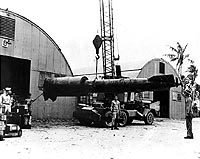
"Kaiten" type human torpedoes were the first Japanese "Special Attack" weapons, vehicles whose operational use involved the certain death of the crew, though their first successful employment followed that of the "Kamikaze" suicide aircraft by about a month. Proposals for human torpedoes were made in 1943 and were approved in early 1944, initially with provision for the survival of the operator. However, the extreme peril facing Japan after the loss of the Marianas in June 1944 led to acceptance of the pilot's death as an inevitable consequence of "Kaiten" use.
The initial "Kaiten", Type 1, was converted from a Type 93 61-centimeter (24-inch) diameter torpedo. A new 1-meter diameter forward section, containing the warhead, additional fuel and oxygen tanks and the pilot's compartment was grafted to the torpedo's middle and after sections, producing an overall length of just over 48 feet. Speed could be varied from 12 knots, giving a range of some 85,000 yards, to 30 knots. Range at the higher speed was about 25,000 yards. For guidance, the pilot had a short periscope. The "Kaiten's " immense 3400-pound explosive warhead, more than three times the size of the Type 93 torpedo's original (and very effective) warhead, was capable of producing catastrophic damage in the target ship. Over 300 Type 1 "Kaitens" were produced in 1944-45.
The larger "Kaiten" Type 2 and Type 4 human torpedoes had hulls about 4 1/2 feet in diameter and 55 feet long. Warhead was as large or larger than that of the "Kaiten" Type 1 and performance was better. The Type 2, featuring hydrogen-peroxide as oxidizer, was not built in any quantity but some 50 of the less-ambitious Type 4's were reportedly built in 1945. There was also an experimental Type 3 "Kaiten" of similar size to the Types 2 & 4, and a Type 10. The latter was converted from 53 centimeter (21-inch) diameter Type 92 electrically-powered submarine torpedoes.
A large number of Japanese submarines and some surface ships were fitted as "Kaiten" carriers, but there were only a few operational successes. On 20 November 1944, a submarine-launched "Kaiten" penetrated the U.S. anchorage at Ulithi, in the Caroline Islands, and sank the oiler USS Mississinewa (AO-59). Eight months later, eastward of the Philippines, another human torpedo caused the loss of destroyer escort USS Underhill (DE-682).
This page features photographs and drawings of Japanese "Kaiten" type human torpedoes, and provides links to other views.
For additional images of Japanese "Kaiten" type
human torpedoes, see:
| If you want higher resolution reproductions than the digital images presented here, see: "How to Obtain Photographic Reproductions." |
Click on the small photograph to prompt a larger view of the same image.
|
Photo #: NH 78668 Japanese Human Torpedoes: "Kaiten" Type 1 (top) and "Kaiten" Type 2 (bottom) Sketch inboard profile plans, 1945. Copied from "Extracts from Small Battle Units of Foreign Powers, Appendix III: Japanese Midget Submarines and Explosive Motor Boats", page 40 (top). U.S. Naval Historical Center Photograph. Online Image: 92KB; 740 x 520 pixels |
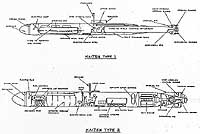 |
|
Photo #: NH 78669 Japanese Human Torpedoes: "Kaiten" Type 4 (top) and "Kaiten" Type 10 (bottom) Sketch inboard profile plans, 1945. Copied from "Extracts from Small Battle Units of Foreign Powers, Appendix III: Japanese Midget Submarines and Explosive Motor Boats", page 40 (bottom). U.S. Naval Historical Center Photograph. Online Image: 73KB; 740 x 500 pixels |
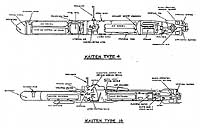 |
|
Photo #: 80-G-350027 Japanese "Kaiten" Type 1 Human Torpedo After recovery by U.S. forces at Ulithi Atoll in 1945. This is the after half of the "Kaiten". The forward portion, including warhead, forward oxygen & fuel tanks and the crew compartment, is missing, and may have been destroyed in an explosion of the warhead. Official U.S. Navy Photograph, now in the collections of the National Archives. Online Image: 99KB; 740 x 615 pixels Reproductions of this image may also be available through the National Archives photographic reproduction system. |
 |
|
Photo #: 80-G-276351 Japanese "Kaiten" human torpedo On a launching carts at Dublon, Truk Atoll, 19 November 1945. This appears to be a non-standard "Kaiten", and may be a locally-produced version. Note its very large conning station, apparently strapped atop a torpedo. Official U.S. Navy Photograph, now in the collections of the National Archives. Online Image: 108KB; 740 x 620 pixels Reproductions of this image may also be available through the National Archives photographic reproduction system. |
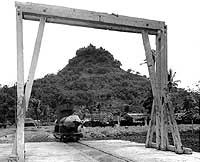 |
|
Photo #: 80-G-339854 Japanese "Kaiten" Type 2 or 4 Human Torpedo View of the afterbody, showing rudders and propellers, with other "Kaiten" in the background, at the Yokosuka Naval Base, Japan, 7 September 1945. Japanese "kanji" character painted on the fairwater of "Kaiten" number 26 is "yoko", probably a unit marking for Yokosuka naval base. Top fin of the "Kaiten" in the foreground features a painted Japanese navy flag. Official U.S. Navy Photograph, now in the collections of the National Archives. Online Image: 78KB; 740 x 620 pixels Reproductions of this image may also be available through the National Archives photographic reproduction system. |
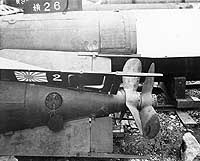 |
For additional images of Japanese "Kaiten" type
human torpedoes, see:
| If you want higher resolution reproductions than the digital images presented here, see: "How to Obtain Photographic Reproductions." |
28 May 2000